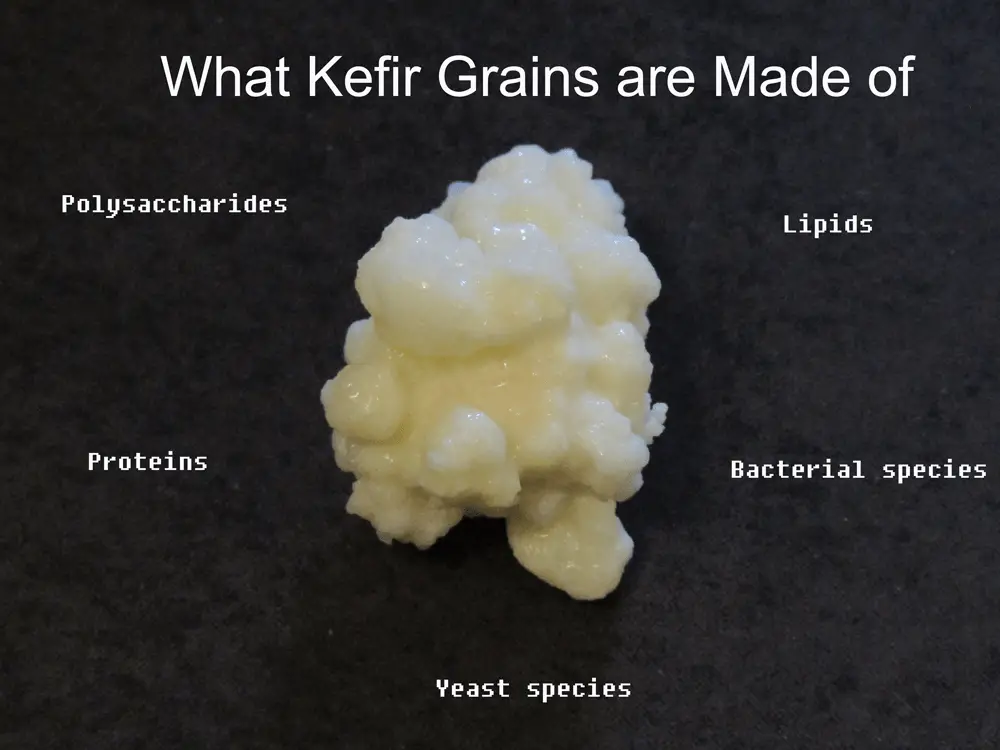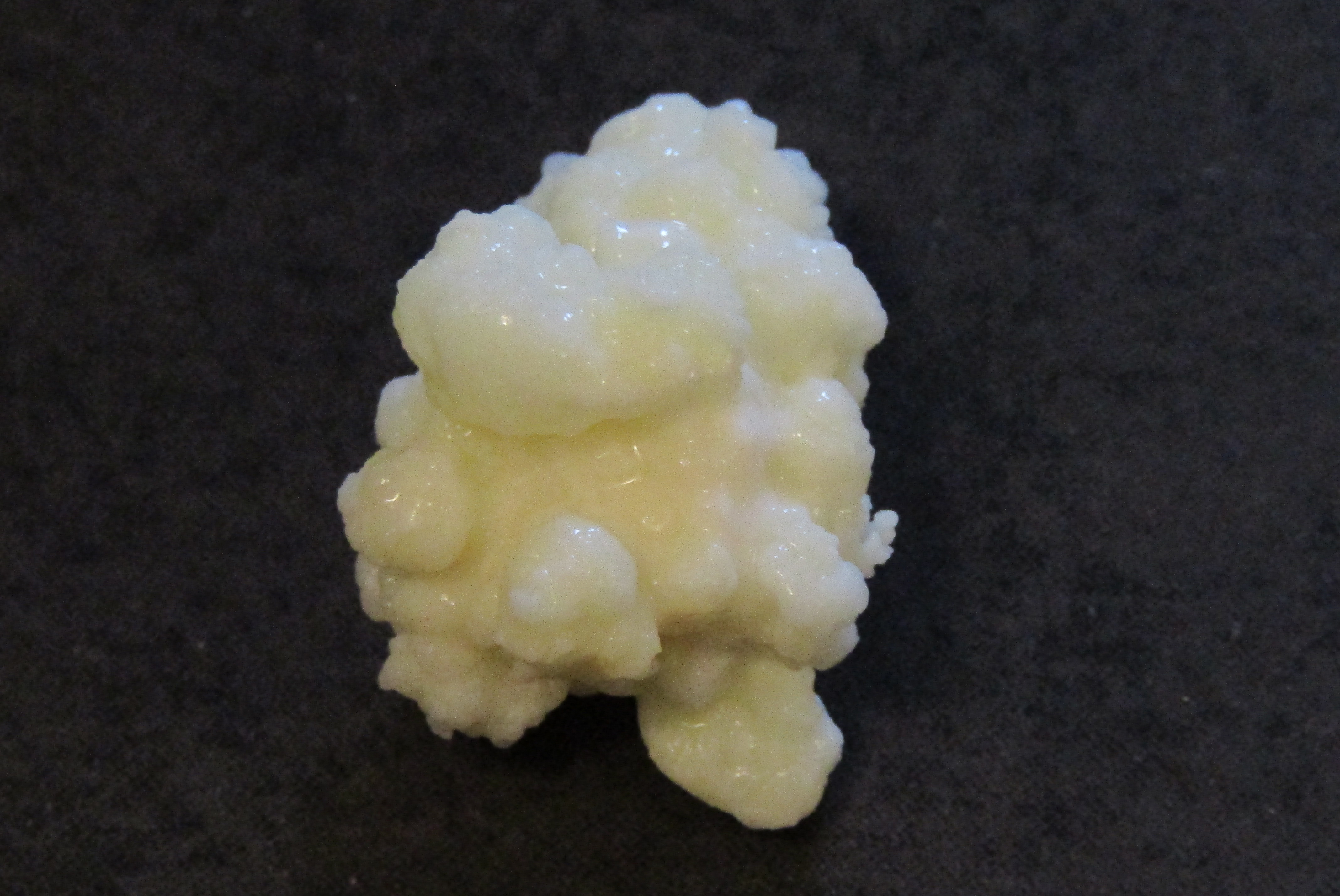This post contains affiliate links.
Once your kefir grains have rehydrated and you have make a few batches of kefir they may start to get bigger and you start to wonder what are they made of.
Kefir grans are made of polysaccharides, proteins and lipids inhabited by various bacterial and yeast species in a symbiotic relationship providing a wide variety of vitamins and minerals. Most of the polysaccharide is produced by L. kefiranofaciens which thickens over time to form the grains.

Kefir grains are a complicated collection of ingredients which are affected by its heritage, current environment and food source. They are continually changing as their environment changes.
For a deeper understanding of the process of making kefir read this great book (affiliate link) on yogurt and kefir. It is full of recipes, techniques and other useful information (at least I found it so).
The chemical components of milk kefir grains
There are five chemical components of kefir grains which have been discovered.
Polysaccharides
This is the slimy coating found on kefir grains when they are strained from freshly made kefir. The slimy coating is made up of long strings of saccharides which cannot be broken down by the resident microbial cultures. The polysaccharide which makes up most of the grain is made by L. kefiranofaciens and Lc. Plantarum as well as other species which have a lesser impact.
Lactic acid bacteria and yeasts cannot break down long chain sugars (saccharide) which are present in the milk. Instead some of these sugars are used to form a biofilm which is the slimy coating surrounding your kefir grains (link to slimy). This biofilm protects the culture from pathogenic invasion.
Proteins
The proteins in the grains have two sources:
Proteins in the milk
Not all of the protein in the milk are usable by the microbial species in the culture and as a result some will get included in your grains as the biofilm thickens.
Proteins from expired cells
When you feed your kefir grains daily they will have access to fresh food and quickly begin to consume it. This causes the yeast and bacteria to multiply quickly but once most of the available food has been consumed some of the microbes die off and get included in the kefir grain.
Lipids
The lipids found in kefir grains are a collection of chemicals which include fats, oils and oil soluble vitamins vitamin A and E. They are included in the grains by getting tangled in the polysaccharide matrix as it thickens.
These three components form a soft cauliflower shaped mass surrounded by a thin layer of biofilm. The highest concentration of bacteria and yeast is found in and around the kefir grains.
Water Based Vitamins
As well as providing fat soluble vitamins kefir also contains some water soluble vitamins which are either made available to you when you consume your kefir or make it through respiration.
These vitamins include:
- Thiamine – B1
- Riboflavin – B2
- Niacin – B3
- Pyridoxine – B6
- Acetic Acid – C
The B vitamins in the list are commonly produced by various yeast species and the acetic acid is produced by the resident acetic acid bacteria which are not present in large numbers but help to reduce the alcohol content in your kefir.
Minerals found in kefir grains
The microbial species in the grains break down some of the components of the milk they are fed and make the minerals which are bound up in the milk more available to you. These minerals include:
- Sodium
- Potassium
- Calcium
- Magnesium
- Phosphate
- Iron
- Zinc
- Selenium
- Copper
- Manganese
Microbial components of milk kefir grains
The microbial components of your kefir grains can vary widely with other kefir grains. The population of the various species found in kefir grains can change over time depending on the environmental conditions, the heritage of the grains and its food source.
Kefir grains are a symbiotic culture which includes lactic acid bacteria, acetic acid bacteria and yeast. This culture changes as the environment changes around it. Kefir grains from around the world all have a different microbial population with some commonalities found throughout the world.
The following table is a list of some of the most common species found worldwide. This does not mean that all kefir grains have all these species in them it is just a list of the most commonly found species in kefir grains from around the world.
| Microbial species commonly found kefir grains |
| Lactobacillus kefiri |
| Lactobacillus kefiranofaciens spp. |
| Lactobacillus helveticus, |
| Lactobacillus casei |
| Lactobacillus kefiri |
| Kluyveromyces marxianus |
| S. cerevisiae |
| Candida spp. |
| Cryptococcus spp. |
| Dekkera anomala |
The following table is a list of all the species which have been found in all the kefir grains studies. Not all kefir grains have anywhere near this many microbial species but all of the following have been part of a set of grains somewhere in the world.
| Microbial species which have found kefir grains |
| Acetobacter acetic |
| Acetobacter fabarum |
| Acetobacter lovaniensis |
| Acetobacter orientalis |
| Acetobacter rancens |
| Acetobacter sp. |
| Acetobacter syzygii |
| Acinetobacter sp. |
| Bacillus sp. |
| Bacillus subtilis |
| Bifidobacterium bifidum |
| Bifidobacterium sp. |
| Brettanomyces sp. |
| Candida inconspicua |
| Candida krusei |
| Candida lambica |
| Candida maris |
| Candida sp. |
| Cryptococcus sp. |
| Dekkera anomala |
| Dysgonomonas sp. |
| Enterococcus durans |
| Enterococcus faecalis |
| Enterococcus sp. |
| Escherichia coli |
| Gluconobacter frateurii |
| Gluconobacter japonicus |
| Halococcus sp. |
| Kazachastania khefir |
| Kazachstania aerobia |
| Kazachstania exigua |
| Kazachstania unispora |
| Kluyveromyces lactis |
| Kluyveromyces marxianus |
| Kluyveromyces marxianus var. lactis |
| Lachancea meyersii |
| Lactobacillaceae |
| Lactobacillus acidophilus |
| Lactobacillus amylovorus |
| Lactobacillus brevis |
| Lactobacillus buchneri |
| Lactobacillus casei |
| Lactobacillus casei ssp. pseudoplantarum |
| Lactobacillus crispatus |
| Lactobacillus delbrueckii ssp. bulgaricus |
| Lactobacillus helveticus |
| Lactobacillus kefir |
| Lactobacillus kefiranofaciens |
| Lactobacillus kefiranofaciens ssp. kefiranofaciens |
| Lactobacillus kefiranofaciens ssp. kefirgranum |
| Lactobacillus kefiri |
| Lactobacillus lactis |
| Lactobacillus lactis ssp. lactis |
| Lactobacillus parabuchneri |
| Lactobacillus paracasei |
| Lactobacillus parakefir |
| Lactobacillus parakefiri |
| Lactobacillus plantarum |
| Lactobacillus satsumensis |
| Lactobacillus sp. |
| Lactobacillus uvarum |
| Lactococcus cremoris |
| Lactococcus lactis |
| Lactococcus lactis ssp. cremoris |
| Lactococcus lactis ssp. lactis |
| Lactococcus lactis ssp. lactis biovar diacetylactis |
| Lactococcus sp. |
| Leuconostoc lactis |
| Leuconostoc mesenteroides |
| Leuconostoc paramesenteroides |
| Leuconostoc pseudomesenteroides |
| Leuconostoc sp. |
| Naumovozyma sp. |
| Pelomonas sp. |
| Pichia guilliermondii |
| Pichia kudriavzevii |
| Pseudomonas sp. |
| Saccharomyces cerevisiae. |
| Saccharomyces sp. |
| Saccharomyces turicensis |
| Saccharomyces unisporus |
| Saccharomycodes sp. |
| Shewanella sp. |
| Streptococcaceae |
| Streptococcus durans |
| Streptococcus sp |
| Streptococcus thermophilus |
| Weissella sp. |
| Zygosaccharomyces sp. |
Kefir grains like many cultures are a product of their environment. Just like sourdough starter it takes on the species of bacteria and yeast which help it to maintain an equilibrium in its current environment. As kefir grains are passed around they pickup different microbes which can be added to the culture if they are beneficial to the community.
How kefir grains grow
Once you start making kefir with kefir grains you may find your grains taking up more and more of the fermenting jar. This is due to the natural tendency for your grains to grow.
The growth is dependent on feeding the bacterial species which produce the major component of the grains which is the biofilm which surrounds the grains. In kefir grains the biofilm is made by the lactic acid bacteria with the help of some acetic acid bacteria. If your kefir grains become overly slimy and you want to know what you can do about it read “Why are my kefir grains slimy?“.
To help your grains grow you need to provide a stable environment which encourages the growth of these microorganisms. This can be done by doing three things:
Feeding the grains regularly
Like every other living thing the species in your grains need adequate food to grow. Feeding your grains regularly will help to provide enough food for the culture to increase in population. As the population increases additional biofilm will be produced and more cell bodies, living and dead, will become entangled in it causing it to thicken.
Provide a steady temperature between 18-25˚C
A steady temperature is important for maximum grain growth as it helps the lactic acid bacteria to grow efficiently. Since these are the bacteria in your grains which are most responsible for grain growth providing the best environment for them will speed growth.
Maintain a low ratio of grains to milk
When you maintain a low grains to milk ratio like 1:10 the grains will have lots of food and room to grow. The cultures in the grains may have a symbiotic relationship but it is still competitive for food and nutrients. Providing your grains with enough food for growth will encourage the grains to grow.

